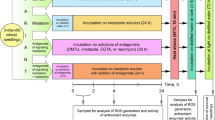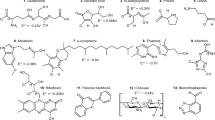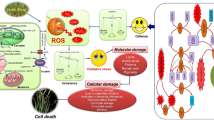Abstract
Exogenous-applied 24-epibrassinolide (EBR) increased the seedling growth of radish (Raphanus sativus L.) in terms of seedling length, fresh weight and dry weight both in zinc (Zn2+)-stressed and unstressed conditions. Moreover, EBR lowered the Zn2+ uptake and bioaccumulation. Increased oxidation of ascorbate (AsA) and glutathione (GSH) pools to dehydroascorbate and glutathione disulfide respectively was observed in Zn2+-stressed seedlings, a clear indication of oxidative stress. However, exogenous application of EBR to stressed seedlings inhibited the oxidation of ascorbate and glutathione, maintaining redox molecules in reduced form. Under Zn2+ stress, enzymatic activities of ascorbate–glutathione cycle such as ascorbate peroxidase, monodehydroascorbate reductase increased but the dehydroascorbate reductase, glutathione reductase decreased. Zn2+ stress induced the gamma-glutamylcysteine synthetase, and glutathione-s-transferase activities in radish seedlings were further enhanced with EBR application. Zn2+ toxicity decreased the thiol content but, EBR supplementation resulted in restoration of thiol pool. The results of present study clearly demonstrated that external application of EBR modulates the AsA and GSH redox status to combat the oxidative stress of Zn2+ in seedlings via the AsA–GSH cycle and glutathione metabolism as an antioxidant defense system.





Similar content being viewed by others
Abbreviations
- CDNB:
-
1-Chloro, 2,4-dinitrobenzene
- EBR:
-
24-Epibrassinolide
- DTNB:
-
5,5′-Dithio-bis-2-nitrobenzoic acid
- AsA:
-
Ascorbate
- APX:
-
Ascorbate peroxidase
- DHA:
-
Dehydroascorbate
- DHAR:
-
Dehydroascorbate reductase
- DTT:
-
Dithiothreitol
- γ-GCS:
-
Gamma-glutamylcysteine synthetase
- GSSG:
-
Glutathione disulfide
- GSH:
-
Glutathione
- GR:
-
Glutathione reductase
- GST:
-
Glutathione-s-transferase
- MDHAR:
-
Monodehydroascorbate reductase
- OPT:
-
O-Phthalaldialdehde
- PMSF:
-
Phenyl methyl sulfonyl fluoride
- PVPP:
-
Polyvinylpolypyrolidone
- Zn2+ :
-
Zinc
References
Allen SE, Grimshaw HM, Parkinson JA, Quarmby C, Roberts JD (1976) Chemical Analysis. In: Chapman SB (ed) Methods in plant ecology. Blackwell Scientific Publications, Oxford, pp 424–426
Andre CM, Yvan L, Daniele E (2010) Dietary antioxidants and oxidative stress from a human and plant perspective: a review. Curr Nutr Food Sci 6:2–12
Apel K, Hirt H (2004) Reactive oxygen species: metabolism, oxidative stress, and signal transduction. Annu Rev Plant Biol 55:373–399
Ashraf M, Akram NA, Arteca RN, Foolad MR (2010) The physiological, biochemical and molecular roles of brassinosteroids and salicylic acid in plant processes and salt tolerance. Crit Rev Plant Sci 29:162–190
Bajguz A (2000) Blockade of heavy metals accumulation in Chlorella vulgaris cells by 24-epibrassinolide. Plant Physiol Biochem 38:797–801
Bajguz A (2002) Brassinosteroids and lead as stimulators of phytochelatins synthesis in Chlorella vulgaris. J Plant Physiol 159:321–324
Bajguz A (2010) An enhanced effect of brassinolide on the growth and antioxidant activity in Chlorella cultures under heavy metal stress. Environ Exp Bot 68:175–179
Bajguz A (2011) Suppression of Chlorella vulgaris growth by cadmium, lead and copper stress and its restoration by endogenous brassinolide. Arch Environ Contam Toxicol 60:406–416
Bajguz A, Hayat S (2009) Effects of brassinosteroids on the plant responses to environmental stresses. Plant Physiol Biochem 47:1–8
Bajguz A, Tretyn A (2003) The chemical structures and occurrence of brassinosteroids in plants. In: Hayat S, Ahamad A (eds) Brassinosteroids bioactivity and crop productivity. Kluwer Academic publishers, The Netherlands, pp 1–44
Bhardwaj R, Arora N, Sharma P, Arora HK (2007) Effect of 28-homobrassinolide on seedling growth, lipid peroxidation and antioxidative enzyme activities under nickel stress in seedlings of Zea mays L. Asian J Plant Sci 6:765–772
Broadley MR, White PJ, Hammond JP, Zelko I, Lux A (2007) Zinc in plants. New Phytol 173:677–702
Choudhary SP, Kanwar M, Bhardwaj R, Gupta BD, Gupta RK (2011) Epibrassinolide ameliorates Cr(VI) stress via influencing the levels of indole-3-acetic acid, abscisic acid, polyamines and antioxidant system of radish seedlings. Chemosphere 84:592–600
Choudhary SP, Oral HV, Bhardwaj R, Yu JQ, Tran LSP (2012) Interaction of brassinosteroids and polyamines enhances copper stress tolerance in Raphanus sativus. J Exp Bot. doi:10.1093/jxb/ers219
Clouse SD (2011) Brassinosteroids. In: The arabidopsis book, vol 9. p e0151. doi:10.1199/tab.0151
Cobbett C, Goldsbrough P (2002) Phytochelatins and metallothioneins: roles in heavy metal detoxification and homeostasis. Annu Rev Plant Biol 53:159–182
Dalton DA, Russell SA, Hans FJ, Pascoe GA, Evans HJ (1986) Enzymatic reactions of ascorbate and glutathione that prevent peroxide damage in soybean root nodules. Proc Natl Acad Sci USA 83:3811–3815
De Gara L, Paciolla C, DeTullio MC, Motto M, Arrigioni O (2000) Ascorbat-dependent hydrogen peroxide detoxification and ascorbate regeneration during germination of highly productive maize hybrid: evidence of an improved detoxification mechanism against reactive oxygen species. Physiol Plant 109:7–13
Di Baccio D, Kopriva S, Sebastiani L, Rennenberg H (2005) Does glutathione metabolism have a role in the defense of poplar against zinc excess? New Phytol 167:73–80
Drazkiewicz M, Skorzynska-Polit E, Krupa Z (2003) Response of the ascorbate-glutathione cycle to excess copper in Arabidopsis thaliana (L.). Plant Sci 164:195–202
Edwards R, Dixon DP, Walbot V (2000) Plant glutathione S-transferases: enzymes with multiple functions in sickness and in health. Trends Plant Sci 5:193–198
Foyer CH, Noctor G (2011) Ascorbate and glutathione: the heart of the redox hub. Plant Physiol 155:2–18
Gill SS, Tuteja N (2010) Reactive oxygen species and antioxidant machinery in abiotic stress tolerance in crop plants. Plant Physiol Biochem 48:909–930
Gonzalez-Gracia MP, Vilarrssa-Blasi J, Zhiponova M, Divol F, Mora-Garcia S, Russinova E, Cano-Delgado AL (2011) Brassinosteroids control meristem size by promoting cell cycle progression in Arabidopsis roots. Development 138:849–859
Habig WH, Jacoby WB (1981) Assay for differentiation of glutathione-S-transferase. In: Jacoby WB (ed) Methods in Enzymology, vol 77. Academic Press, New York, pp 398–405
Hissin PJ, Hilf R (1976) A fluorimetric method for determination of oxidized and reduced glutathione in tissues. Anal Biochem 74:214–226
Hodges DM, Andrews CJ, Johnson DA, Hamilton RI (1996) Antioxidant compound responses to chilling stress in differentially sensitive inbred maize lines. Physiol Plant 98:685–692
Hoque MA, Banu MNA, Okuma E, Amako K, Nakamura Y, Shimoishi Y, Murata Y (2007) Exogenous proline and glycinebetaine increase NaCl-induced ascorbate-glutathione cycle enzyme activities, and proline improves salt tolerance more than glycinebetaine in tobacco Bright Yellow-2 suspension-cultured cells. J Plant Physiol 164:1457–1468
Janeczko A, Kościelniak J, Pilipowicz M, Szarek-Lukaszewska G, Skoczowski A (2005) Protection of winter rape photosystem 2 by 24-epibrassinolide under cadmium stress. Photosynthetica 43:293–298
Jiang X, Wang C (2008) Zinc distribution and zinc-binding forms in Phragmites australis under zinc pollution. J Plant Physiol 165:697–704
Jiang M, Zhang J (2001) Effect of abscisic acid on active oxygen species, antioxidative defense system and oxidative damage in leaves of maize seedlings. Plant Cell Physiol 42:1265–1273
Lowry OH, Rosebrough NJ, Farr AL, Randall RJ (1951) Protein measurement with the Folin phenol reagent. J Biol Chem 193:265–275
Mateos-Naranjo E, Redondo-Gomez S, Cambrolle J, Luque T, Figueroa ME (2008) Growth and photosynthetic responses to zinc stress of an invasive cord grass, Spartina densiflora. Plant Biol 10:754–762
Michalak A (2006) Phenolic compounds and their antioxidant activity in plants growing under heavy metal stress. Polish J Environ Stud 15:523–530
Miyake C, Asada K (1992) Thylakoid-bound ascorbate peroxidase in spinach chloroplasts and photoreduction of its primary oxidation product monodehydroascorbate radicals in thylakoids. Plant Cell Physiol 33:541–553
Morina F, Jovanovicb L, Mojovicc M, Vidovica M, Pankovicd D, Jovanovic SV (2010) Zinc-induced oxidative stress in Verbascum thapsusis caused by an accumulation of reactive oxygen species and quinhydrone in the cell wall. Physiol Plant 140:209–224
Nagalaxmi N, Prasad MNV (2001) Reponses of glutathione cycle enzymes and glutathione metabolism to copper stress in Scenedesmus bijugatus. Plant Sci 160:291–299
Nakano Y, Asada K (1981) Hydrogen peroxide is scavenged by ascorbate specific peroxidase in spinach chloroplasts. Plant Cell Physiol 22:867–880
Noctor G, Foyer CH (1998) Ascorbate and glutathione: keeping active oxygen under control. Annu Rev Plant Physiol Plant Mol Biol 49:249–279
Ogawa K, Hatano-Iwasaki A, Yanagida M, Lwabuchi M (2004) Level of glutathione is regulated by ATP-dependent ligation of glutamate and cysteine through photosynthesis in Arabidopsis thaliana: mechanism of strong interaction of light intensity with flowering. Plant Cell Physiol 45:1–8
Polle A (2001) Dissecting the superoxide dismutase–ascorbate–glutathione-pathway in chloroplasts by metabolic modeling: computer simulations as a step towards flux analysis. Plant Physiol 126:445–462
Ramakrishna B, Rao SSR (2012) 24-Epibrassinolide alleviated zinc-induced oxidative stress in radish (Raphanus sativus L.) seedlings by enhancing antioxidative system. Plant Growth Regul. doi:10.1007/s10725-012-9713-3
Sagardoy R, Morales F, Lopez-Millan AF, Abadı′a A, Abadı′a J (2009) Effects of zinc toxicity on sugar beet (Beta vulgaris L.) plants grown in hydroponics. Plant Biol 11:339–350
Sedlak J, Lindsay RH (1968) Estimation of total, protein-bound, and nonprotein sulfhydryl groups in tissue by Ellman’s reagent. Anal Biochem 25:192–208
Sharma P, Bhardwaj R, Arora N, Arora HK, Kumar A (2008) Effects of 28-homobrassinolide on nickel uptake, protein content and antioxidative defence system in Brassica juncea. Biologia Plant 52:767–770
Sharma I, Pati PK, Bhardwaj R (2011) Effect of 28-homobrassinolide on antioxidant defence system in Rapahnus sativus L. under chromium toxicity. Ecotoxicology 20:862–874
Tewari RK, Kumar P, Sharma PN (2008) Morphology and physiology of zinc-stressed mulberry plants. J Plant Nutr Soil Sci 171:286–294
Vardhini BV, Anuradha S, Sujatha E, Rao SSR (2010) Role of brassinosteroids in alleviating various abiotic and biotic stresses-A Review. Plant Stress 4:55–61
Vriet C, Russinova E, Reuzeau C (2012) Boosting crop yields with plant steroids. Plant Cell 24:842–857
Wang C, Zhang SH, Wang PF, Qian J, Hou J, Zhang WJ, Lu J (2009) Excess Zn alters the nutrient uptake and induces the antioxidative responses in submerged plant Hydrilla verticillata (L.f.) Royle. Chemosphere 76:938–945
White PJ, Broadley MR (2005) Biofortifying crops with essential mineral elements. Trends Plant Sci 10:586–593
Xia XJ, Zhang Y, Wu JX, Wang JT, Zhou YH, Shi K, Yu YL, Yu JQ (2009) Brassinosteroids promote metabolism of pesticides in cucumber. J Agric Food Chem 57:8406–8413
Xiang CB, Oliver DJ (1998) Glutathione metabolic genes coordinately respond to heavy metals and jasmonic acid in Arabidopsis. Plant Cell 10:1539–1550
Yang CJ, Zhang C, Lu YN, Jin JQ, Wang XL (2011) The mechanism of brassinosteroids action: from signal transduction to plant development. Mol Plant 4:588–600. doi:10.1093/mp/ssr020
Yuan LY, Du J, Yuan YH, Shu S, Sun J, Guo SR (2012) Effects of 24-epibrassinolide on ascorbate-glutathione cycle and polyamine levels in cucumber roots under Ca(NO3)2 stress. Acta Physiol Plant doi. doi:10.1007/s.11738-012-1071-2
Acknowledgments
The financial support to Bellamkonda Ramakrishna under the UGC-RFSMS Scheme from University Grants Commission, New Delhi, India is greatly acknowledged.
Author information
Authors and Affiliations
Corresponding author
Additional information
Communicated by A. Gniazdowska-Piekarska.
Rights and permissions
About this article
Cite this article
Ramakrishna, B., Seeta Ram Rao, S. 24-Epibrassinolide maintains elevated redox state of AsA and GSH in radish (Raphanus sativus L.) seedlings under zinc stress. Acta Physiol Plant 35, 1291–1302 (2013). https://doi.org/10.1007/s11738-012-1168-7
Received:
Revised:
Accepted:
Published:
Issue Date:
DOI: https://doi.org/10.1007/s11738-012-1168-7




